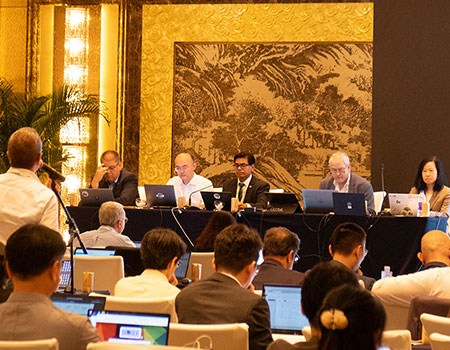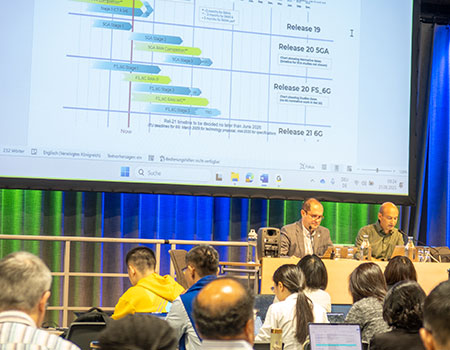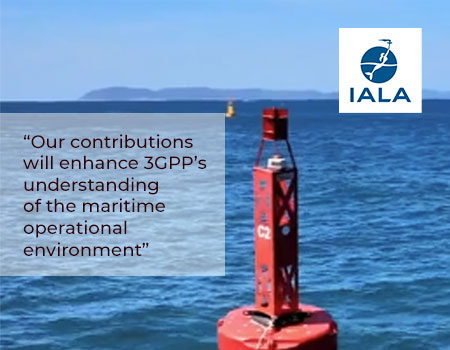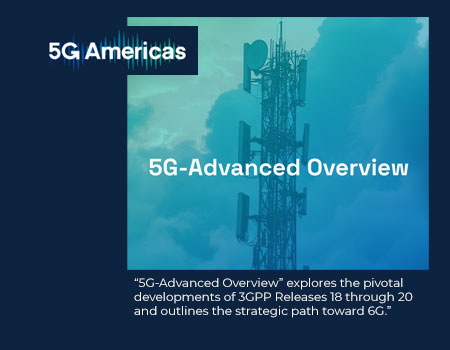3GPP SA6 accelerates work on new verticals!
June 7, 2019
By Suresh Chitturi, 3GPP Working Group SA6 Chair, Samsung.
Following the modification of the group’s Terms of Reference (ToR) in 2017, 3GPP SA6 Working Group has gradually expanded its activities. While mission-critical applications are still very much central to the SA6 charter, fresh initiatives - since the beginning of Release 15 work - are paving the way for the standardization of new vertical applications within the 3GPP ecosystem, and also promoting the adoption of 3GPP 5G technology across a variety of industries.
Common API Framework (CAPIF)
During Release 15, the Common API Framework (CAPIF) was developed to enable a unified Northbound API framework across 3GPP network functions, and to ensure that there is a single and harmonized approach for their development (Refer to 3GPP TS 23.222, TS 33.122 and TS 29.222).
This work has been successfully delivered and integrated with Northbound APIs developed by 3GPP SA2 Working Group (SCEF/NEF) and 3GPP SA4 (xMB). It is further expected that all future Northbound API development in 3GPP, will be compliant with CAPIF. This ensures that there is a single entry point for vertical applications (a.k.a. API invokers) towards the common API aspects (also called CAPIF APIs) such as onboarding, discovery, authentication and authorization.
The CAPIF framework has evolved in Release 16 (eCAPIF), to bring in key features such as support for 3rd party domains i.e. to allow 3rd party API providers to leverage the CAPIF framework, the support for interconnection between two CAPIF providers and the federation of CAPIF functions to support distributed deployments.
SEAL - Service Enabler Architecture Layer for Verticals
Also in Release 16, SEAL has been introduced to support vertical applications (e.g. V2X applications). 3GPP TS 23.434 specifies application plane and signalling plane entities for application-enabling services (e.g. group management, configuration management, location management, identity/key management, network resource management); that can be reused across vertical applications.
SEAL also specifies the northbound APIs for its individual services - to enable flexible integration with vertical applications. As we progress further with new verticals, SEAL is expected to evolve to support more common capabilities based on their requirements.
V2XAPP - Application layer support for V2X services
V2XAPP is introduced, in Release 16, to enable the efficient use and deployment of V2X services over 3GPP systems. The specification of V2XAPP is available in 3GPP TS 23.286, and the architecture is based on the notion of a V2X Application Enabler (VAE) layer that interfaces with one or more V2X applications. The VAE layer is in turn developed on top of the SEAL architecture.
The focus of V2XAPP is to provide key capabilities such as V2X message distribution, service continuity, application resource management, dynamic group management and VAE server APIs over the Evolved packet system (EPS) capabilities - as specified in 3GPP TS 23.285.
3GPP Release 17 Studies
Several new studies (prefix ‘FS’) are underway in Rel-17 further expanding the horizon of new vertical applications within 3GPP:
FS_EDGEAPP - Architecture for enabling Edge Applications
The objectives include the development of application layer requirements and architecture for hosting Edge Applications on the Edge Data Network, including the exposure of northbound APIs towards Edge Applications, and integration of the edge enabling layer with the 3GPP Network.
The study is based on key architecture principles such as UE mobility, Edge Application portability, service differentiation and flexible deployment. It is expected to be complete by December 2019, with the results captured in 3GPP TR 23.758.
FS_UASAPP - Application layer support for Unmanned Aerial System (UAS)
Will evaluate the necessary application layer architecture and solutions based on Stage 1 requirements (3GPP TS 22.125) to enable the UAS application aspects (e.g. fly route authorization, location management, group communication, UAV to UTM communications) on the 3GPP network.
This effort will be done in coordination with 3GPP SA2’s study (FS_ID_UAS) that will look into the system aspects of UAS. The study is expected to be completed in March 2020, with the results captured in 3GPP TR 23.755.
FS_FFAPP - Application layer support for Factories of the Future
Aims to investigate the general applicability of Factories of the Future based on service requirements of cyber-physical control applications identified in 3GPP TS 22.104 and TS 22.261, and develop corresponding solutions to ensure the efficient use and deployment of application layer support for Factories of the Future in 5G networks. The study is expected to be completed in Dec 2019, with the results captured in 3GPP TR 23.745.
FS_eV2XAPP - Application layer support for V2X services
Enhancing the capabilities of existing application layer solutions specified in V2XAPP (Rel-16). The primary objective is to expand the application layer architecture to utilize 5G system capabilities for V2X services which are specified in 3GPP TS 23.287. The study is expected to be completed in March 2020.
Bringing it all together
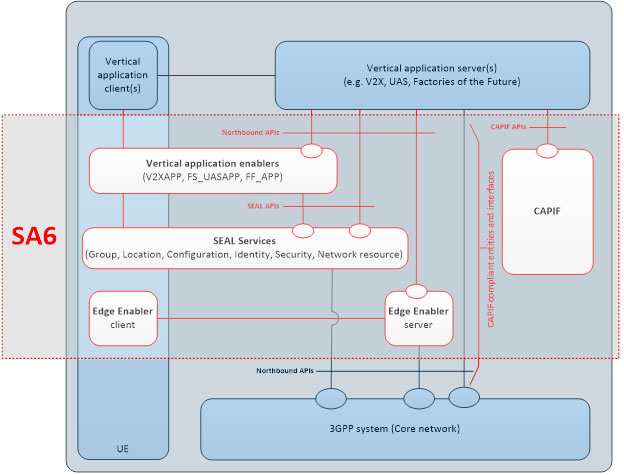
Figure: Illustration of SA6 initiatives to enable 5G vertical applications
Conclusion
SA6 has established a good momentum on vertical applications, both in terms of the core application architecture enablers with CAPIF, SEAL and EDGE, and initiating work on vertical specific enablers such as V2X, UAS, and Smart Factories.
With the initial set of application integration standards, we are moving towards pushing the boundaries of 3GPP beyond the traditional system and radio standards.
Want to be an API Invoker?! Do your industry or technology experts want to join us and help shape future 3GPP work to meet the needs of vertical markets? If so, consider joining us at our next SA6 meeting.
Acknowledgements
I would like to thank the following people for their help in preparing this article:
Alan Soloway, Jukka Vialen, Nishant Gupta, Basavaraj Pattan, Niranth Amogh, Kevin Flynn
Acronyms
API (Application Programming Interface)
CAPIF (Common API Framework)
FF (Factories of the Future)
SEAL (Service Enabler Architecture Layer)
UAS (Unmanned Aerial System)
VAE (V2X Application Enabler)
V2X (Vehicle-to-everything)
Contact for this article: Kevin FLYNN, Marketing and Communications Officer, 3GPP


 3GPP News
3GPP News
